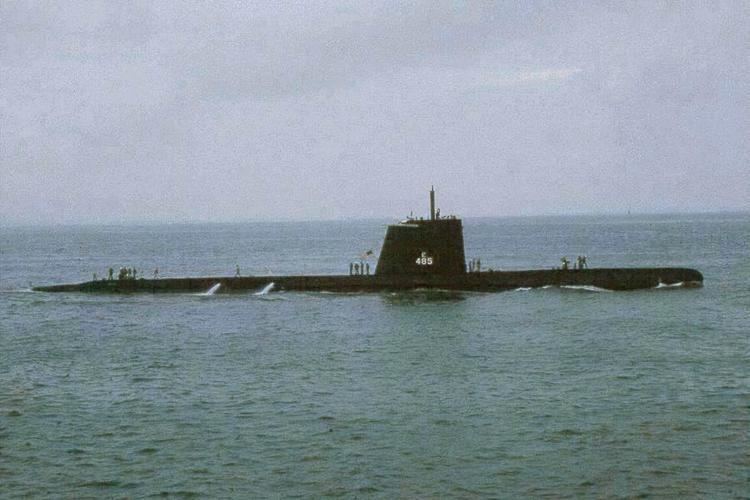Laid down 3 January 1945 Decommissioned 1 June 1972 Construction started 3 January 1945 Builder Portsmouth Naval Shipyard | Commissioned 13 August 1945 Struck 1 June 1972 Launched 11 May 1945 | |
 | ||
Fate Sold for scrap, 2 May 1973 Class and type Tench-class diesel-electric submarine | ||
USS Sirago (SS-485), a Tench-class submarine, was named for the sirago, a small, freshwater tropical fish.
Contents
Construction and launch
Her keel was laid down on 4 January 1945 at the Portsmouth Navy Yard in Kittery, Maine. She was launched on 13 May 1945, sponsored by Mrs. L. Mendel Rivers and commissioned on 13 August 1945 with Commander F. J. Harlfinger, II, in command.
First duties
Commissioned at the end of World War II, Sirago conducted her shakedown cruise off the East Coast and in the Caribbean Sea during the fall of 1945. After shakedown, she joined Submarine Squadron (SubRon) 8 at New London, Connecticut, and, in January 1946, she proceeded to Provincetown, Massachusetts, where she participated in the destruction of two German submarines. On returning to New London, Sirago commenced duties that included training services for the Submarine School and for the fleet's destroyer force; experimental exercises to evaluate new techniques and equipment; type training; and fleet exercises that took her from Davis Strait into the Caribbean. In December 1948, she entered the Philadelphia Naval Shipyard for a Greater Underwater Propulsive Power Program (GUPPY) conversion; and, on 25 July 1949, she left the yard for Norfolk, Virginia, where, as a modernized high-speed attack submarine, she joined SubRon 6.
Attached to SubRon 6 for the next twenty-two years, Sirago’s primary mission was antisubmarine warfare. Secondary missions included antishipping warfare, intelligence gathering, and the provision of services for research and development studies. Those duties, during the 1950s, continued to see her operating primarily in the western Atlantic as she participated in exercises with others of her ASW group; in fleet exercises; in joint Canadian-United States exercises, and in NATO exercises, which took her into the eastern Atlantic Ocean and North Sea areas. During the 1950s, she also deployed to the Mediterranean Sea where she operated as a unit of the Sixth Fleet from September to November 1951 and from September to December 1954.
Fatal accident
An explosion aboard Sirago while drydocked at Portsmouth, New Hampshire, on 2 June 1954, killed two men and injured four others. The blast, which occurred during plastic spraying of a main ballast tank. killed two civilian painters and injured a sailor and three other civilian painters. The burst was heard three miles away.
Overhaul and new service
In October 1962, Sirago entered the Norfolk Naval Shipyard for another extensive overhaul which included the installation of a fiberglass superstructure and sail and, in the spring of 1963, she resumed operations with her ASW group, Task Group "ALFA." That fall, she deployed to the Middle East for CENTO exercise "MIDLINK VI"; but, during the remainder of the 1960s and into the 1970s, her operations were similar to those of the 1950s.
On 1 July 1971, with Commander Clyde H. Shaffer Jr. in command, Sirago was reassigned to SubRon 12 at Key West, Florida; but, less than four months later, on 15 October, she was ordered back to Norfolk, where she rejoined SubRon 6 for one more year.
Decommissioning
Sirago remained in SubRon 6 until she was decommissioned on 1 June 1972. Struck from the Naval Vessel Register on the same day, she was turned over to the Naval Ships Systems Command and sold for scrapping to the Jacobson Metal Company of Chesapeake, Virginia, on 2 May 1973.
